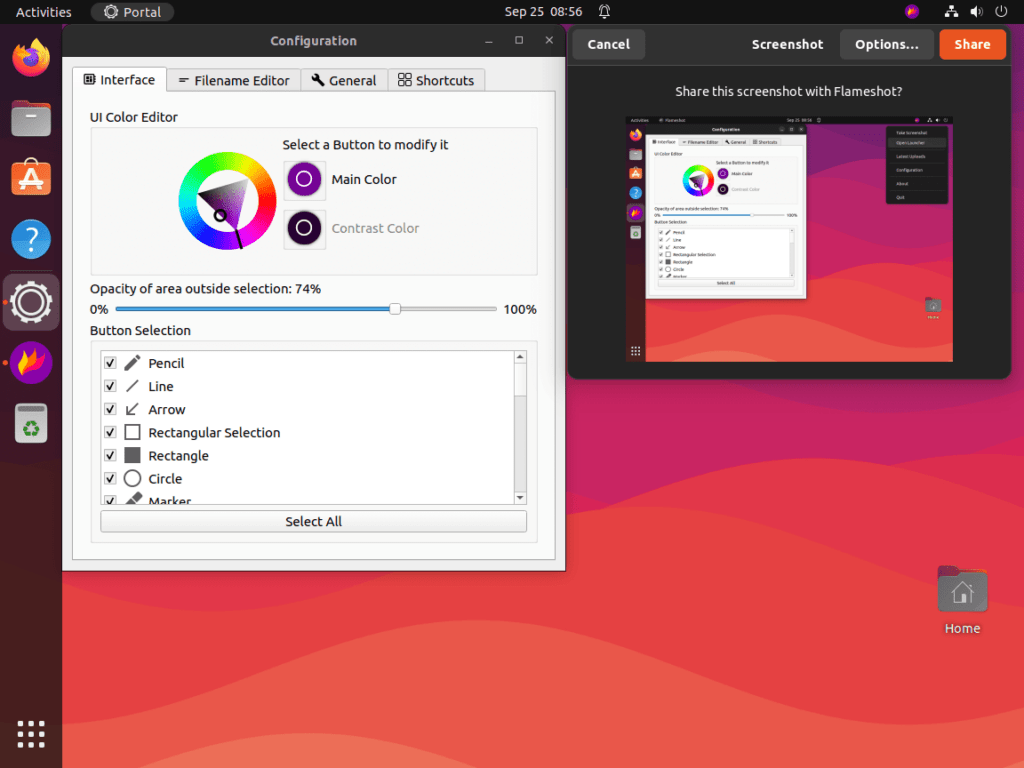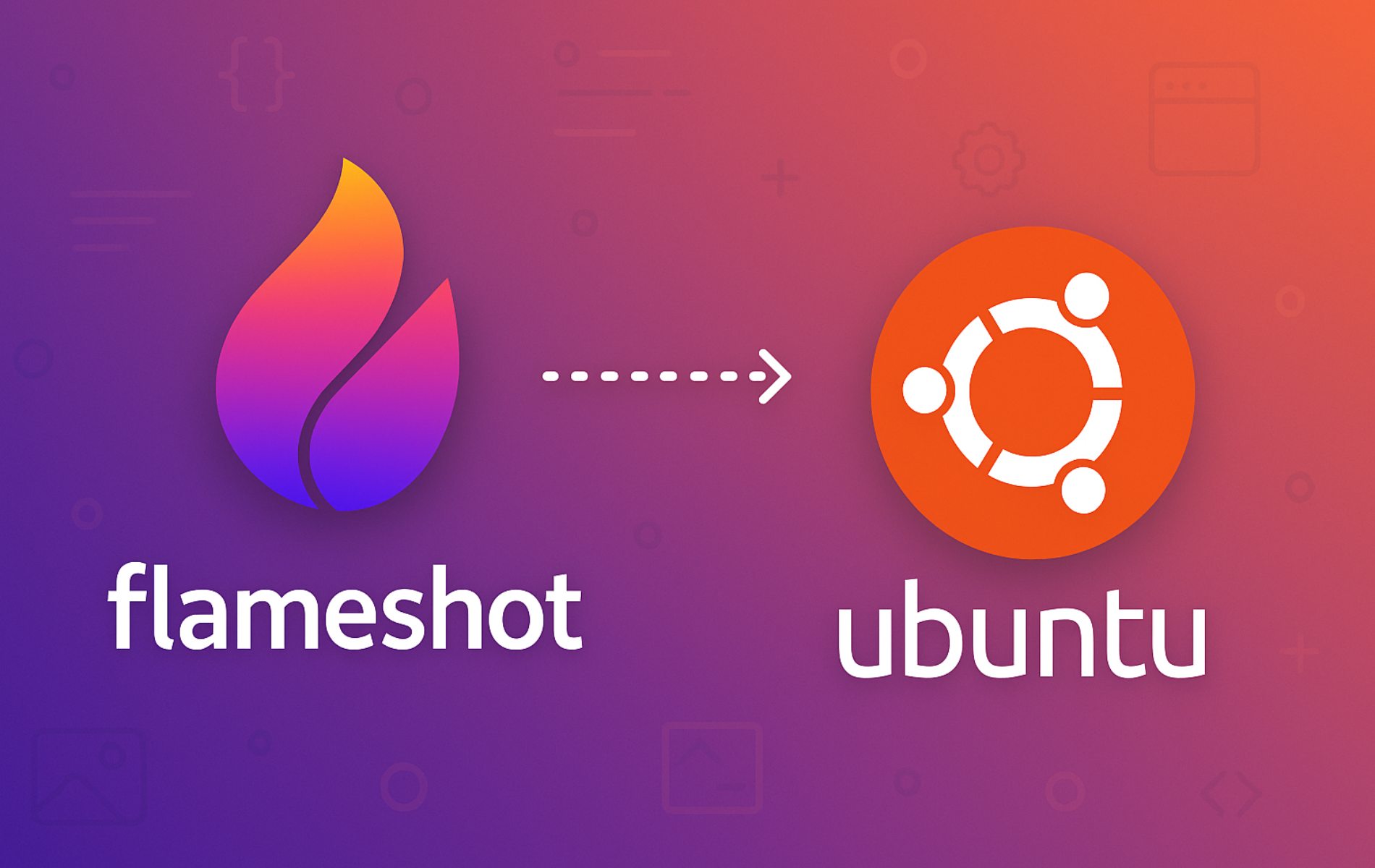Flameshot lets you capture, annotate, and share screenshots on Ubuntu without leaving the application. Whether you need to blur sensitive information in bug reports, add arrows and text to explain a workflow, or quickly copy a region to your clipboard for pasting into documentation, Flameshot handles it directly in its capture interface. By the end of this guide, you will have Flameshot installed and ready to use, with commands for capturing full screens, custom regions, and delayed screenshots.
Choose Your Flameshot Installation Method
Ubuntu offers three ways to install Flameshot, each with different trade-offs for version freshness and system integration. The table below summarizes your options.
| Method | Channel | Version | Updates | Best For |
|---|---|---|---|---|
| APT | Ubuntu Repos | Stable | Automatic via apt upgrade | Most users who want distro-tested packages |
| Flatpak | Flathub | Latest | Automatic via flatpak update | Users who want newer releases with sandboxing |
| Snap | Snapcraft | Latest | Automatic via snapd | Users who prefer Snap integration |
For most users, the APT method is recommended because it provides automatic security updates through standard system upgrades and requires no additional setup. However, Flatpak and Snap offer newer versions if you need the latest features, though they require their respective frameworks.
Method 1: Install Flameshot via APT
Update System Packages
Before installing new software, refresh your package index to ensure you receive the latest available version from Ubuntu’s repositories.
sudo apt update && sudo apt upgradeInstall Flameshot from Ubuntu Repositories
Flameshot is available in Ubuntu’s default repositories, making installation straightforward. Simply run the following command to install it:
sudo apt install flameshotVerify APT Installation
Once installation completes, confirm Flameshot is accessible by checking its version:
flameshot --versionExpected output (version varies by Ubuntu release):
Flameshot v1x.x.x Compiled with Qt 5.x.x
Ubuntu 24.04 LTS provides Flameshot 12.x while Ubuntu 22.04 LTS includes version 11.x. Both versions offer the same core functionality documented in this guide, though newer versions may include additional annotation tools and bug fixes.
Method 2: Install Flameshot via Flatpak
Alternatively, Flatpak provides sandboxed applications that run independently of your system’s package versions. This method typically offers newer Flameshot releases than the Ubuntu repositories.
Flatpak is not pre-installed on Ubuntu. If you have not set it up yet, install it with
sudo apt install flatpakand restart your session before continuing. For detailed setup including the Flathub repository, follow our Flatpak installation guide for Ubuntu.
Add Flathub Repository
First, add the Flathub repository if you haven’t already. This command is safe to run even if Flathub is already configured:
sudo flatpak remote-add --if-not-exists flathub https://flathub.org/repo/flathub.flatpakrepoInstall Flameshot from Flathub
Next, with Flathub configured, install Flameshot using the following command:
sudo flatpak install flathub org.flameshot.Flameshot -yVerify Flatpak Installation
Finally, confirm the Flatpak installation succeeded by checking the application info:
flatpak info org.flameshot.FlameshotExpected output includes the application ID, version, and installation location:
Flameshot - Powerful yet simple to use screenshot software
ID: org.flameshot.Flameshot
Ref: app/org.flameshot.Flameshot/x86_64/stable
Arch: x86_64
Branch: stable
Origin: flathub
Version: 1x.x.x
Method 3: Install Flameshot via Snap
As another option, Snap packages are self-contained applications that include all dependencies. Since Ubuntu includes Snap by default, this method is convenient for most desktop installations.
Verify Snap Availability
Although Ubuntu includes Snap by default, minimal installations may lack it. If you previously removed Snap or are using a minimal installation, reinstall it with:
sudo apt install snapd -yInstall Flameshot from Snapcraft
Then, install Flameshot using the Snap package manager:
sudo snap install flameshotVerify Snap Installation
Afterward, confirm the Snap installation by listing installed Snap packages:
snap list flameshotExpected output shows the installed version and channel:
Name Version Rev Tracking Publisher Notes flameshot 1x.x.x xxx latest/stable flameshot✓ -
Launch Flameshot
Launch from Terminal
With Flameshot installed, you can launch it immediately from the terminal. The command varies depending on your installation method:
APT installation:
flameshotFlatpak installation:
flatpak run org.flameshot.FlameshotSnap installation:
flameshotLaunch from Applications Menu
Ubuntu desktop users can launch Flameshot from the graphical interface. Open the Activities overview and search for “Flameshot,” or navigate to:
Activities > Show Applications > Flameshot
Once launched, Flameshot adds a tray icon for quick access to captures and configuration.

Flameshot Command Examples
Flameshot offers extensive command-line options for automation and scripting. The following examples demonstrate common capture scenarios.
Capture with Interactive Selection
To begin, open the GUI capture mode where you can select a region and annotate before saving:
flameshot guiTo save captures to a specific directory instead of the default location:
flameshot gui --path ~/Pictures/screenshotsAdditionally, you can add a delay before the capture starts, which is useful for capturing menus or tooltips. The delay is specified in milliseconds:
flameshot gui --delay 3000Capture Full Screen
Capture the entire desktop without interactive selection. This command prompts for a save location:
flameshot fullFurthermore, for automated captures, you can specify both the save path and a delay:
flameshot full --path ~/Pictures/screenshots --delay 5000Similarly, to capture the full screen and copy it to the clipboard while also saving to disk:
flameshot full --clipboard --path ~/Pictures/screenshotsConfigure Flameshot Settings
Open the configuration dialog to adjust default save paths, colors, and behavior:
flameshot configEnable or disable the help message that appears during capture mode:
flameshot config --showhelp trueAdditionally, you can validate your configuration file for syntax errors:
flameshot config --checkTo explore further, view all available configuration options:
flameshot config --helpCapture Specific Monitor
For multi-monitor setups, capture a specific screen by its number. Screens are numbered starting from 0:
flameshot screen --number 0By default, Flameshot captures the screen containing the cursor. Combine with other options like --clipboard or --path for automated workflows.
Set Up Keyboard Shortcut
Binding Flameshot to a keyboard shortcut enables quick screen captures without opening a terminal. On GNOME (Ubuntu’s default desktop), navigate to:
Settings > Keyboard > Keyboard Shortcuts > Custom Shortcuts
Click the + button and add a new shortcut with the following settings:
- Name: Flameshot
- Command:
/usr/bin/flameshot gui - Shortcut: Press your preferred key combination (e.g.,
Print ScreenorCtrl+Shift+S)
After saving, the assigned shortcut opens Flameshot’s interactive capture mode immediately. If you installed Flameshot via Flatpak, use flatpak run org.flameshot.Flameshot gui as the command instead.
Manage Flameshot
Update Flameshot
To keep Flameshot current with the latest features and security fixes, run the appropriate update command for your installation method.
APT installation: Update Flameshot specifically without upgrading all system packages:
sudo apt update && sudo apt install --only-upgrade flameshotFlatpak installation: Update all Flatpak applications or specify Flameshot directly:
flatpak update org.flameshot.FlameshotSnap installation: Snap automatically updates packages, but you can trigger a manual refresh:
sudo snap refresh flameshotRemove Flameshot
If you no longer need Flameshot, remove it using the command matching your installation method.
APT installation:
sudo apt remove flameshotAfter removal, clean up any orphaned dependencies that were installed alongside Flameshot:
sudo apt autoremoveFlatpak installation: Remove the application and its associated data:
sudo flatpak uninstall --delete-data org.flameshot.Flameshot -ySnap installation:
sudo snap remove flameshotRemove Flameshot Configuration Files
Additionally, Flameshot stores user configuration in your home directory. To remove these settings after uninstalling:
Warning: The following command permanently deletes your Flameshot configuration, including custom save paths, color preferences, and filename patterns. Back up this directory first if you plan to reinstall later.
rm -rf ~/.config/flameshotTroubleshooting
Flameshot Does Not Capture on Wayland
If Flameshot fails to capture or shows a black screen on Ubuntu with Wayland, the application may lack the necessary portal permissions.
First, check if you are running Wayland:
echo $XDG_SESSION_TYPEIf the output shows wayland, install the required portal package:
sudo apt install xdg-desktop-portal-gnomeAlternatively, switch to an X11 session by selecting “Ubuntu on Xorg” from the gear icon on the login screen. Flameshot works reliably under X11 without additional configuration.
Flameshot Tray Icon Not Visible
On GNOME, the system tray is hidden by default. Install the AppIndicator extension to display Flameshot’s tray icon:
sudo apt install gnome-shell-extension-appindicatorAfter installation, log out and back in, then enable the extension through GNOME Extensions or by running:
gnome-extensions enable appindicatorsupport@rgcjonas.gmail.comDBus Error When Launching
If you see an error mentioning DBus or the application fails to start, Flameshot may already be running in the background. Check for existing processes:
pgrep -a flameshotIf a process is found running, terminate it and restart:
pkill flameshot && flameshotConclusion
You now have Flameshot installed on Ubuntu with keyboard shortcuts configured for quick captures. The CLI commands and multi-monitor options covered here enable automation for documentation workflows, while the GUI annotation tools let you highlight and annotate screenshots before sharing. For additional features like Imgur upload integration and custom filename patterns, explore the configuration dialog or review the official documentation.
Useful Links
For more information about Flameshot, visit these official resources:
- Flameshot Official Website: Project overview, features, and download options.
- Flameshot Documentation: Comprehensive guides for configuration, troubleshooting, and advanced usage.
- Flameshot GitHub Repository: Source code, issue tracker, and release notes.



Thanks for sharing your knowledge about flameshot. For me it is essential in my Ubuntu installation.
Thanks Paco for the feedback.